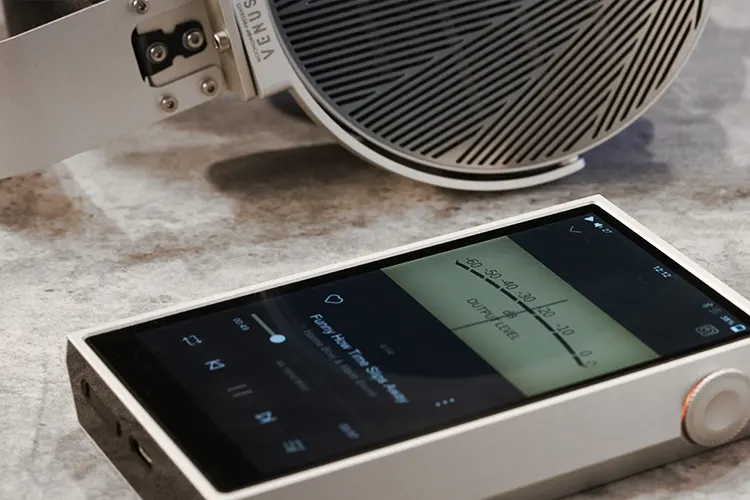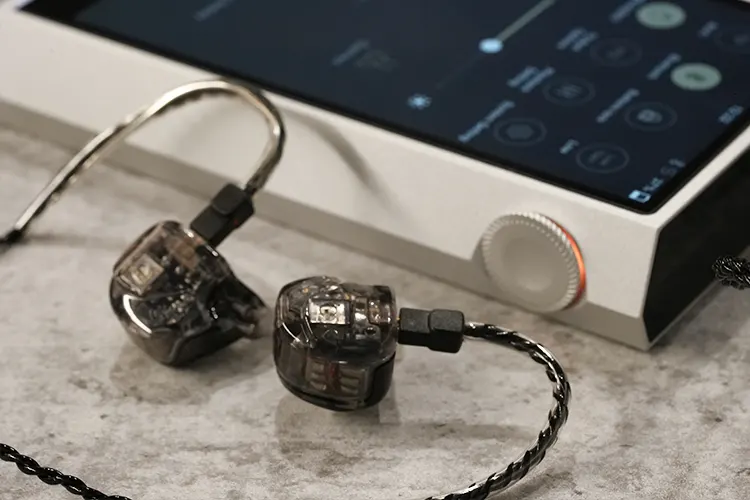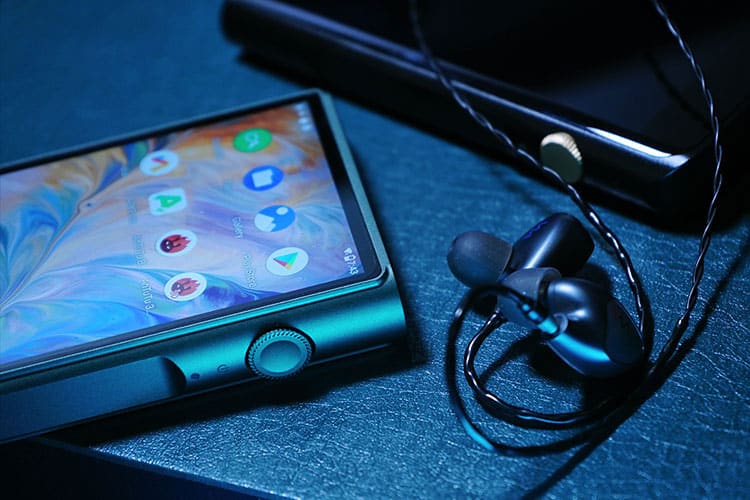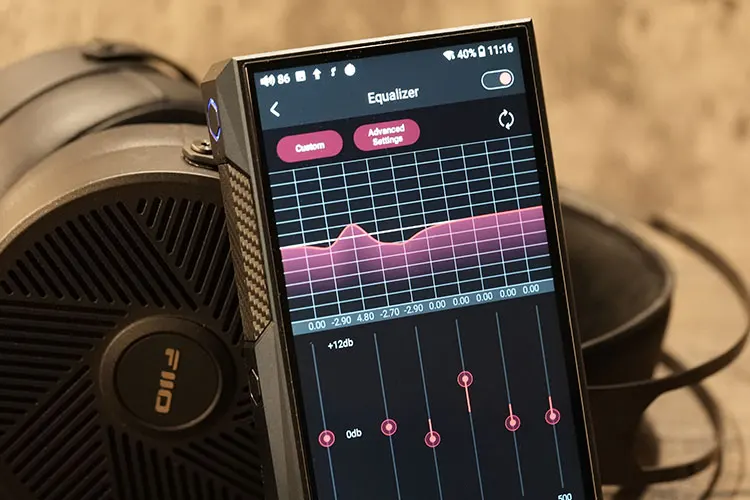Synergy
Efficiency
The M5 Ultra delivers a very quiet and black background, even at the highest gain level.
Perhaps this is because of the non-Android OS’s natural advantage as there is much less going on in the background. The cleaner internals and lighter OS help the M5 Ultra to achieve higher dynamic range performance and to sound more dynamic in practice.
Power
The high output power and 3 levels of gain control allow good versatility in pairing. The two higher levels are more suitable for high-impedance headphones and IEMs.
I am also quite surprised to find that the M5 Ultra can drive the demanding Moondrop VENUS which sounds firm and dynamic in the lower end with nicely defined vocals, even on a mid-gain setting.
IEMs generally only need a low to mid-gain setting. There are adequate dynamics and air, though you may find very sensitive IEMs such as the HiBy ZETA to sound more flattened but even so, it still maintains a firm bass impact and adequate extension.
Pairings
The tuning on the M5 Ultra highlights the mids and smoothly renders the two ends. It pairs well with resolving multi-BA designs with stronger transients, as well as dynamic drivers that benefit from the driving power and lifted upper vocal range details.
With the Shanling MG800, the M5 Ultra pairing sounds clean and punchy in the mid-low, with vocal performances clearly cutting through the mix. Using the Westone Audio MACH 30, this pairing sounds very lush in the mids and the bass kicks a bit deeper than what I am used to.
Higher impedance IEMs like the Earsonics SWITCH 300 Pro also benefit from the excellent output power delivering strong dynamics and a smooth, rounded response.
The tonal signature and output power from the M5 Ultra also work great with Planar headphones. It offers good distortion control but sometimes sounds cooler in tone, adding more vibrance and fullness to the overall output.
The effect when changing the gain on the M5 Ultra is quite obvious as it alters the forwardness of the vocal as well as the attack firmness of the bass.
I would consider it an alternative way to tweak the output tonality, though you may find some IEMs sound flattened when driving with high gain and work better with lower gain levels.
Select Comparisons
Shanling M6 Ultra
Technical
The M6 Ultra is equipped with 4*AK4493SEQ decoders and unlike the pure music implementation on the M5 Ultra, it is based on Android 10.
The max decoding rate supported for both devices comes head to head with a ceiling at DSD512 and 32bit/768kHZ for PCM.
The output power on the M6 Ultra goes as high as 720mW on balanced output and 240mW for SE output which is quite a bit less than the 1100mW balanced and 315mW SE output power on the M5 Ultra.
Design
The M5 Ultra’s design language is differentiated from the M6 Ultra. I am calling it an upgrade as it looks cooler and more futuristic with the new faceted design and backlit elements.
Since the M5 Ultra doesn’t run Android, it is not as flexible in terms of OS features and less expansive with apps.
Despite this, when it comes to the music playback experience and using Tidal, it feels more straightforward and involves fewer steps to navigate to the album, which is preferable.
Performance
When testing with the MOONDROP PARA, both pairings sound dynamically powerful. The M5 Ultra offers a more relaxing and mid-centric presentation, while the M6 Ultra provides a more resolving sound.
The M5 Ultra’s presentation is colored, with a slightly darker background which enhances the perceived dynamics.
The bass on the M5 Ultra sounds punchier, with emphasized decay and harmonics. Whereas the M6 Ultra delivers a more precise and textured presentation with faster recovery speed and less emphasis on the bass quantity.
The M5 Ultra exhibits stronger coloration in vocals compared to the M6 Ultra, which favors streaming content to sound fuller. The upper vocal range is slightly brighter on the M5 Ultra, while the M6 Ultra is more naturally tuned and articulates the treble more naturally.
Although the M6 Ultra delivers a more comprehensive and accurate performance with better extension, the vocal coloration of the M5 Ultra gives it a more euphonic sound. It is particularly suitable for certain music genres that have an intense mid-range presence and vocal-centric tracks.
Another interesting observation is that when using IEMs to test such as the MG800 from Shanling, the M6 Ultra portrays a delicate and controlled soundscape, presenting a distinct and more separated yet refined vocal image.
On the other hand, the M5 Ultra exhibits a vivid tuning with a forward upper vocal range, which feels more dispersed yet punchier and more immersive. The vocal blends more intimately with the richer mid-bass, yet the sub-bass doesn’t sound as deep.
FiiO M23
Technical
Both FiiO M23 and Shanling M5 Ultra use the same set of AK4191 and AK4499EX DACs.
The output power on the M5 Ultra is roughly 10% higher than on the M23, while the THD+N performance on the M23 reaches <0.00038% and >125dB which is technically better than the <0.0007% and >124dB on the M5 Ultra.
The M23 goes over M5 Ultra’s max decoding rate by supporting native DSD1024 and 32bit/1536kHz for PCM, which is the maximum rate the AKM chipset can decode.
With the innovative desktop mode design the M23 can be powered externally to boost its output power while bypassing the in-built battery. This is a sensible move for those who use the device with both USB-source at home with higher loadings as well as carrying the DAP outdoors.
Design
Both devices feature a faceted design. The M23 is comparatively more complicated with plenty of physical control buttons, whereas the M5 Ultra looks much cleaner. The M5 Ultra feels thicker yet lighter, and I regard both devices as equally portable.
Again, the M23 is Android based which gives it more flexibility with Google Play Store installed. The M23 also features two USB-C ports which makes it more versatile in terms of charging and connectivity.
Performance
I found that both devices have distinct characteristics that set them apart from each other.
The M5 Ultra leans towards being more mid-centric and organic in its sound signature. Whereas the M23 is tuned to be more all-rounded and focuses on revealing details throughout the entire audio spectrum.
The M5 Ultra exhibits more apparent thickness in the lower mids, which, combined with the lifted upper mids, creates a lusher and more vibrant presentation.
On the other hand, the M23 offers a swifter presentation in the mids and is not as elaborate in the bass and its harmonics. However, it excels in responsiveness, delivering a more textured sound and showcasing stronger technicalities in capturing transients, especially for fast bowing and impactful, cleaner bass attacks.
The M23 sounds softer when powered by the battery, while in AC-powered desktop mode, it becomes cleaner outlined and provides stronger output when dealing with heavier loads. This is more obvious when you are testing with higher-impedance gear.
Overall, the M23 exhibits greater extension and accuracy in the bass compared to the M5 Ultra. It is a tonal signature that favors classical music and well-mastered tracks.
Conversely, the M5 Ultra delivers bass with more weight and sustains a longer duration, which works better for pop and slower, bass-intensive tunes.
The M23 has a slight edge over the M5 Ultra in terms of pairing with sensitive gear and sound wider in staging
However, when it comes to more power and demanding headphones, the M5 Ultra sounds more dynamic and fuller, exhibiting stronger separation for the vocal range and a darker background.
My Verdict
The Shanling M5 Ultra is an affordable portable digital audio player for audiophiles who want audio performance over OS features, one that is also capable of driving higher loads to sound engaging.
If only it supported more music apps there could be more flexibility, while the navigation experience is satisfactory but still has room to improve.
As to the question of whether sacrificing these OS features helps enhance sound quality, I firmly believe that the M5 Ultra has achieved this balance effectively.
It not only delivers high power but also a dynamic and organic sound profile, reminiscent of a less defined, more mid-centric, yet richly colored version of the M9 Plus.
Shanling M5 Ultra Technical Specifications
- Dimensions: 120 x 75 x 19.5 mm
- Weight: 247 g
- DAC: AKM AK4499EX + AK4191
- Amplifier: Dual TPA6120A
- Platform: Ingenic X2000
- System: MTouch developed by Shanling
- Screen: 4.7-inch 1280 x 720 Touchscreen
- Memory: MicroSD card slot
- Hi-Res Support: PCM 32 bit / 768 kHz & DSD512
- USB Input: XMOS XU316
- Wi-Fi: 2.4/5G, supporting DLNA, Airplay, NAS and OTA Updates
- Bluetooth: Upgraded 5.2 with Bi-Directional support of LDAC, aptX HD, aptX, AAC
- Companion app: Eddict Player app through SyncLink
- Connectors: 3.5mm Single-Ended, 4.4mm Balanced, USB-C
- Battery: 6000 mAh
- Battery life: Up to 11 hours
Single-Ended Output:
- Power: 315 mW @ 32 Ohm
- THD+N: 0.0009%
- Channel Separation: 75 dB
- SNR: 121 dB
- Output impedance: 4.7 Ohm
Balanced Output:
- Power: 1100 mW @ 32 Ohm
- THD+N: 0.0007%
- Channel Separation: 110 dB
- SNR: 124 dB
- Output impedance: 6.6 Ohm






